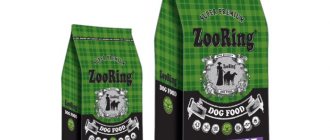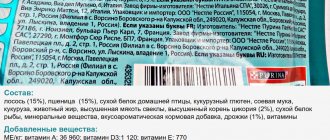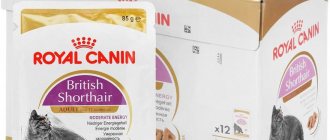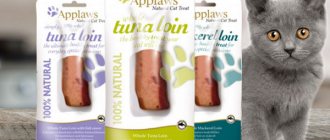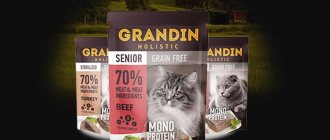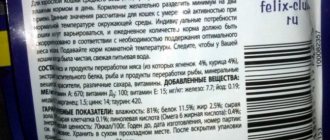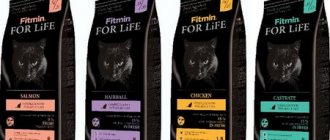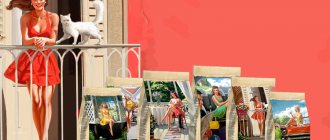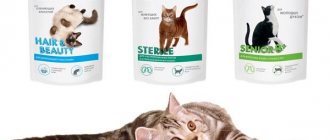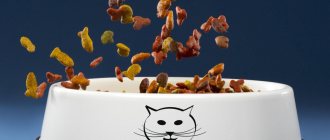general information
Officially, Eukanuba food belongs to the super-premium class. The products were of high quality when they were produced by the Procter and Gamble corporation. In the summer of 2014, the company sold the brand to Mars. Since then, the recipe began to deteriorate, they began to include increasingly cheaper ingredients and reduced the proportion of meat. Despite the assurances of the manufacturers, in fact the food belongs to the premium class.
There are several versions of the logo, but this is the most common and is present on most Eukanuba food packaging.
Initially, the Eukanuba formula was just an offshoot of the main Yams brand. Paul Yams, the company's founder, wanted to give the food a different name to highlight the updated recipe.
The release of such products reduces trust in the manufacturer
Mars Corporation has a controversial reputation among pet owners. It produces budget foods: Whiskas, Kitiket, Sheba, Perfect Fit, Royal Canin, etc. Additionally, there is a wide range of dog diets.
Types of feed "Eukanuba"
The corporation produces 6 types of dry food and 6 types of wet diets. There are products for kittens, adult and senior cats. There are no therapeutic diets, but there are preventative ones: for overweight animals, for hair removal, etc.
Kitten food
The company produces wet and dry food for kittens.
Wet food
Wet food is recommended to be used as an intermediate link when switching from mother's milk to dry ready-made diets. Dense pellets with low moisture levels can cause digestive upset in animals. In some cases, gastrointestinal pathologies even develop due to a sharp restructuring of the body. Many kittens refuse pellets and prefer soft food. To switch to adult diets, animals are first offered wet food, then soaked in dry food, and only then given the latter in its original form.
Wet food for kittens contains the following ingredients:
- meat and offal (including chicken at least 26%);
- cereals;
- vitamins and minerals;
- amino acid methionine;
- fish fat.
The manufacturer states that this is a complete food, i.e. it can be given to a cat throughout its life without additional additives. It already contains the necessary vitamins, microelements and other useful substances. Unfortunately, the manufacturer achieves balance through individual additives rather than whole components, but this is a standard situation for wet food.
It is advisable to introduce wet food into the diet from 4–6 weeks
The company highlights the following advantages of the formula:
- Optimal protein content for healthy growth and development of internal organs.
- Support the immune system with antioxidants.
- Ability to control urine pH levels.
- Improved coat and skin health with fish oil.
- Strengthening the muscle corset with animal proteins.
- Improved digestion due to plant fibers and the presence of prebiotics in the composition.
In fact, the manufacturer names many imaginary advantages. For example, protein in the feed is only 7.6%. This is not very much, especially considering that the composition includes cereals as a cheap filler. I do not recommend using Eukanuba wet food instead of complete food: I am familiar with more than one case where a kitten, having matured, was then unable to eat pelleted foods and suffered from gastrointestinal diseases. Often, in animals that eat only jellies and sauces, inflammation of the paraanal glands is detected. They are cleaned naturally during bowel movements, but when eating soft food, minced meat and puree, the feces become too soft and do not cause excess secretion to be released. As a result, the glands become clogged, inflamed and enlarged. Symptoms can only be eliminated through manual cleansing. Often, even after normalization of pets’ diet, relapses occur.
Dry food
Dry food for kittens is high in fish oil. It contains unsaturated fatty acids, which are necessary for the proper functioning of the brain and nervous system, strengthening the immune system, improving the condition of the skin and coat, etc.
The composition of dry food "Eukanuba" includes the following components:
- animal proteins (43% – poultry, a natural source of taurine);
- animal fat;
- barley;
- wheat;
- Wheat flour;
- rice;
- dry whole egg;
- hydrolyzed animal protein;
- sugar beet pulp;
- fish fat;
- fructooligosaccharides;
- dried brewer's yeast;
- minerals.
The benefits declared by the manufacturer are the same. Additionally, the company emphasizes that dry food helps maintain dental health by mechanically cleaning the surface. In reality this is not the case. Dry food itself not only does not clean the teeth completely, but also provokes the appearance of plaque stones. My first cat started having problems with her mouth when she was 3-4 years old. Then I thought that Eukanuba and Royal Canin foods were the best, so I gave them to her. First my gums became inflamed, then I noticed tartar. I had to go to the vet. The specialist explained to me that only special medicinal foods with a porous texture are suitable for prevention. They really clean the entire surface, because when pressed they fall inward. A regular product does not have this effect: the granules simply break apart. Pieces of food clean only the ends, pushing the plaque closer to the roots. As a result, it accumulates and turns into solid deposits.
The manufacturer suggests giving dry food to kittens per month, but even if the granules are pre-soaked, it is advisable not to immediately switch the animal to a mono-diet
The composition of dry food is slightly better than wet food, but still clearly does not reach the super-premium class. In the first place is not meat, but animal proteins - an ingredient of dubious quality. “Bird” is also not a specific component. These designations can mean either duck or turkey, or chicken or other dubious sources of protein. Judging by the names of the ingredients, the production does not use pure meat, but a mixture of claws, beaks, feathers, etc. If the corporation had nothing to hide, they would indicate the type of component: dehydrated meat, fresh fillet, or at least flour.
The manufacturer does not indicate calorie content, but the fat content of the feed is quite high - 24%. The company suggests giving the product to pregnant and lactating cats. Due to the high fat content, it can be dangerous for unhealthy animals, so it is advisable to seek veterinary advice first. The share of proteins is 36%. This is a good indicator, but given the predominance of cereals, the advantage is doubtful.
Food for adult cats
The company produces several varieties of dry and wet food for adult cats.
Wet food
There are 4 types of wet food. The main difference lies in the main ingredient and taste of the product. Since the composition of different types of food is approximately the same, we will consider only one sample.
Formally, the food actually contains rabbit, but its share is minimal
The wet ready-made rabbit diet contains the following ingredients:
- meat and offal (including rabbit at least 4%);
- cereals;
- vitamins and minerals;
- amino acid methionine;
- fish fat.
4% meat is very little. The mark “including” indirectly indicates that other varieties are also used in production. Considering that chicken feed contains more of the main ingredient (24%), rabbit is not the main component, but a flavoring additive. This looks like a dubious marketing ploy. As in the case of its analogue for kittens, it is better not to use wet food for systematic feeding.
Dry food
The company produces 3 types of dry food. In this case, they differ not in flavor additives, but in specialization. One food is universal, the rest can be used for prevention. Let's take a look at each ready-made diet to understand whether the manufacturer keeps its promises regarding improving the health of animals.
Universal chicken food is suitable for animals without special needs, as it contains a standard amount of nutrients: proteins, fats, vitamins, etc.
Universal chicken feed contains the following components:
- animal proteins (poultry 41%, natural source of taurine);
- rice;
- animal fat;
- wheat;
- vegetable fibers;
- hydrolyzed animal protein;
- sugar beet pulp;
- dry whole egg;
- fructooligosaccharides;
- minerals;
- dried brewer's yeast;
- fish fat.
The food is not suitable for cats that are prone to allergic reactions due to the presence of wheat in the composition. It often causes intolerance. Beet pulp is a good supplement that improves digestion, but given the high grain content, it seems superfluous: the product already has enough fiber. The whole egg is the only quality source of animal protein, but its share is too small. The only meat component is animal proteins. It's a low quality ingredient that could actually be anything. The proportion of fish oil is very small, so it is present here, rather, to balance the balance or as a marketing ploy.
The food for sterilized cats and overweight animals includes the following components:
- animal proteins (poultry 35%, natural source of taurine);
- wheat;
- barley;
- Wheat flour;
- animal fat;
- rice;
- dry whole egg;
- hydrolyzed animal protein;
- sugar beet pulp;
- minerals;
- dried brewer's yeast;
- fructooligosaccharides;
- fish fat.
Food for sterilized animals must meet 2 main requirements: low calorie content and the prevention of urolithiasis. It is impossible to check whether a product meets the first criterion due to a lack of information: the manufacturer does not indicate the nutritional value of ready-made diets. This can already be considered a significant disadvantage, since buyers can only take their word for it. With the prevention of urolithiasis, the situation is even worse. The composition not only does not contain a single therapeutic ingredient, but also has an increased concentration of phosphorus and calcium. This was found out during research by Roskachestvo: the actual amount of microelements differs from that indicated by the manufacturer. This provokes the formation of stones. I personally know of 2 cases where cats developed urolithiasis after eating Eukanuba food. Then I didn’t know what it was connected with, and I thought it was just a coincidence. When I encountered negative reviews, I became convinced that these were not isolated episodes.
In fact, the food is absolutely not suitable for sterilized animals: many buyers complain that it contains salt, although the manufacturer hides this
If we compare food for sterilized cats with a standard ready-made diet, the former is much inferior. The proportion of meat in it is even lower (35% versus 41%). There are more grains, with wheat in second place and divided into 2 separate ingredients: wheat flour and wheat. Probably, if not for this marketing ploy, the beans would have taken first place. This is a powerful allergen, so its presence in feed is not recommended. Even budget rice is better, because it is less likely to cause negative reactions from the immune system. If the animal develops an allergy, owners of sterilized cats will not be able to find an analogue.
The food for removing hairballs from the gastrointestinal tract includes the following components:
- animal proteins (poultry 43%, natural source of taurine);
- animal fat;
- wheat;
- vegetable fibers;
- sugar beet pulp;
- rice;
- Wheat flour;
- dry whole egg;
- hydrolyzed animal protein;
- minerals;
- fructooligosaccharides;
- dried brewer's yeast;
- fish fat.
In general, the food is able to cope with its task: the composition includes vegetable fibers and beet pulp. Plant fibers capture hairs and remove them from the gastrointestinal tract before the hair clumps and clogs the intestines. However, the prepared diet contains few nutrients, which in itself can provoke increased hair loss.
The manufacturer decided to fight not the cause, but the consequences: it is necessary not only to remove hair from the stomach, but also to prevent its excessive loss with the help of a high concentration of animal proteins and fish oil
Despite the presence of therapeutic additives (albeit not the highest quality), I cannot recommend this food. A friend of mine has 2 long-haired Scottish cats at home. They used to shed a lot. This not only created aesthetic inconvenience, but also harmed the health of the animals. Cats have been observed vomiting hairballs. It turned out that the animals eat the preventative food “Eukanuba”. I advised them to switch to Orijen products. At first, my friend was hesitant because of the relatively high price, but then she finally decided. After 2 months, attacks of vomiting began to bother the cats less frequently. A year later the problem was forgotten.
Food for older cats
There are 2 types of food for older cats: dry and wet. The line contains only 2 products.
Wet food
The presence of wet food in the series for older cats is in itself commendable, since many animals lose part of their teeth by the age of 10–12 years. Oral diseases can make it difficult for pets to chew hard, dry kibble. Sometimes this causes a refusal to eat or even the appearance of wounds and their further infection.
Wet food with such a poor composition is a dubious decision, because it is necessary to intensively maintain the health of depleted internal organs
The wet food contains the following ingredients:
- meat and offal (including chicken at least 26%);
- cereals;
- vitamins and minerals;
- amino acid methionine;
- fish fat.
The composition completely coincides with the list of ingredients of food for kittens and partially with the list of components of similar diets for adult cats. Even the amount of added vitamins is the same. The obvious difference lies only in the ratio of BZHU: proteins in food for older cats are 8.5%, and fats are 4%. This is more than in a ready-made diet for kittens, but the difference is not fundamental. The manufacturer claims that the food supports heart health. Most likely, this is provided by fish oil, which is also present in other similar products.
Dry food
In theory, dry food for older cats should be enriched with therapeutic additives to maintain the health of the urinary system, musculoskeletal system and heart muscle. Cranberries can act as an oxidizing agent. To obtain glucosamine and chondroitin, cartilage, shellfish extract, crab shells, etc. are used. A high concentration of animal proteins is encouraged. Pets absorb plant compounds less well, and amino acids are required to maintain muscle mass. Fats help maintain brain and cardiovascular health and provide energy to the body. The food should be low in calories, as the risk of weight gain increases in old age.
The food contains the following ingredients:
- animal proteins (poultry 44%, natural source of taurine);
- animal fat;
- wheat;
- barley;
- Wheat flour;
- rice;
- dry whole egg;
- hydrolyzed animal protein;
- sugar beet pulp;
- minerals;
- fructooligosaccharides;
- dried brewer's yeast;
- fish fat.
There are practically no differences between the lists of ingredients. The food resembles ready-made diets for adult cats and kittens in composition. The difference lies only in the ratio of components: this product contains 19% fat and 37% protein. Such a concentration of lipids can worsen health if you are prone to gastrointestinal diseases, so it is advisable to consult a veterinarian in advance. This is especially important if the animal has chronic pathologies.
Dry food is practically no different from other products in the line in composition, and there is no information on calorie content, so the question involuntarily arises about the advisability of switching to a different diet
Food for older cats can hardly be called high quality. It does not contain any preventive additives. There are even no vegetable fibers, which theoretically could save the animal from problems with hairballs. In old age, pets' digestion becomes more sensitive, and the condition of their joints worsens. Such food not only does not promote health in any way, but also causes harm. Wheat can cause digestive disorders. Several times I observed how lameness appeared in elderly cats eating Eukanuba food. Poor nutrition increases the risk of cartilage and joint destruction, which in the worst case can lead to disability. Of course, diseases of the musculoskeletal system develop not because of Eukanuba feed, but because of excessive load and natural destructive processes, but a balanced diet could smooth out the consequences and prevent or slow down the progression of pathologies.
Range
Include the following types:
Dry food
Kitten Healthy Start. Food for babies with chicken meat. Veterinarians point to excess fat, which can cause digestive disorders, and excess minerals, which is contraindicated for sterilized individuals. Pros: almost 90% protein components.
Adult Top Condition. Food for cats from one year old. Not suitable for castrated cats, as the percentage of minerals and fats is too high. Plus: prevention of urolithiasis.
Adult Sterilized/Weight Control. Diet food option. It contains a minimum of fatty components and contains L-carnitine, which suppresses the feeling of hunger and stimulates metabolic processes. Judging by the inscription on the package, it can be used as a prophylactic against ICD.
Hairball Control. Suitable for cats with long hair and for those living in an apartment. There is a lot of fiber in the composition, there is fish oil (small amount). The manufacturer assures that this food will not allow wool to collect in the stomach into lumps.
Senior Top Condition. Designed for older animals with weak gums. Probiotics, antioxidants and other components indicated in the composition support the immune system and gastrointestinal tract, eliminating the formation of tartar. But the fat content percentage is 19%, which is unacceptable for very old animals.
Wet food
Eukanuba wet food has approximately the same composition as dry food. They include meat and offal (not listed), cereals (in second place in volume), vitamin and mineral complex (origin not specified), amino acids, fish oil (in minimal concentration).
Veterinary ruler
There is also a veterinary line, but several years ago (before the rights to the Mars Corporation transferred the rights to the brand to others) it was much wider.
What's on sale now:
Eukanuba Dermatosis LB. Dietary food for pets prone to allergic reactions. It improves metabolic processes in the body, reduces the manifestations of food allergies, relieves inflammatory processes, and boosts the immune system. Prescribed for chronic external otitis, food intolerance, miliary and common dermatitis, colitis, gastroenteritis, inflammatory bowel diseases. Ingredients: lamb liver, lung and lamb meat, corn oil, barley, beet pulp, sodium chloride, calcium chloride, dicalcium phosphate, vitamins. Contraindicated if you are allergic to lamb and barley.
Eukanuba Intestinal. For cats with gastrointestinal problems. Contains easily digestible ingredients (freeze-dried turkey and chicken meat, corn grits, dry sugar beet pulp, dried chicken eggs, etc.), does not contain allergens. often prescribed in complex therapy (after cancer, enteritis, parasitic infestation, intestinal surgery). Contraindicated in kittens and adolescents, pregnant and lactating cats.
Eukanuba Renal. A dietary product that is prescribed to cats with kidney failure and liver diseases. Ingredients: corn grits and flour, soy protein isolate, animal fat, potassium chloride, sodium chloride, chicken extract, calcium carbonate, fish oil, fructooligosaccharides, freeze-dried turkey and chicken. , beet pulp. Contraindicated in pregnant and lactating cats, adolescents and children.
Eukanuba Urinary Oxalate. For animals suffering from oxalate stones (low calcium levels). But it is also allowed as a dietary feed due to its balanced calorie and fat content. It contains chicken meat and liver, eggs, white fish and fishmeal. Contraindications: FLUTD associated with struvite urolithiasis, growth period, pregnancy, lactation.
Analysis of the composition of Eukanuba feed
Most often, the most nutritious and healthy food in the line is food for kittens. Let's take them as samples. Let's consider 2 ready-made diets: granulated and wet.
The dry food contains the following ingredients:
- Animal proteins (43% poultry, a natural source of taurine). Neither the type of ingredient (fresh, raw, dehydrated) nor its source is specified. “Poultry” is a general definition that allows the manufacturer to create a new recipe each time. Since it is stated that proteins are used, processed feathers, waste, bones, etc. may be added to the feed.
- Animal fat. Ingredient source missing. Questionable component.
- Barley. It causes allergies less frequently than wheat and corn, but its presence in cat food in large quantities is not advisable.
- Wheat. Dangerous component. Causes allergies.
- Wheat flour. The ingredient was added to the list in order to visually reduce the proportion of wheat. This is comparable to an attempt to deceive the buyer.
- Rice. Grain rarely causes allergies, but it also does not represent anything valuable in cat food.
- Dry whole egg. Good source of animal protein. Unfortunately, this is not a fresh whole egg, which has more of the substances preserved.
- Hydrolyzed animal protein. Questionable component. The disadvantages are the same as in the case of animal proteins.
- Sugar beet pulp. Used in many feeds as a source of plant fiber. Helps cleanse the intestines.
- Fish fat. Overall a good ingredient, but the quality may be low. If the fat was extracted from the carcasses of northern fish, it is a valuable source of fatty acids and vitamins. Otherwise, the component may be spoiled or contain heavy metal impurities.
- Fructooligosaccharides. They are prebiotics. They contribute to the normalization of natural microflora. Prebiotics improve digestion and reduce the risk of contracting intestinal infections.
- Dried brewer's yeast. They contain proteins, but they are almost not absorbed by the cat's body. The main feature of yeast is its high concentration of B vitamins.
- Minerals. It is preferable to list specific names and dosages.
Upon detailed analysis, it becomes obvious that the manufacturer is trying to achieve an optimal balance of nutrients by any means. Even if you have to add questionable ingredients. The food becomes like a pacifier, which has been additionally enriched with vitamin and mineral complexes: there is no whole meat, but there is a lot of grains and individual substances.
The feed granules are very light, which indicates an insufficient content of meat components
Wet food for kittens contains the following ingredients:
- Meat and offal (including chicken at least 26%). It's still better than animal proteins, but the quality of the ingredient is questionable. The component is a mixture about which we know only one thing: 26% of the volume is chicken. With equal success it can be fillets, whole carcasses, or even feathers with bones.
- Cereals. A mixture of unknown varieties of plant materials. An undesirable ingredient, especially in wet food. Its presence indicates that the manufacturer has decided to save money. Grains may include wheat or chicken, so owners of allergic animals may want to choose a different brand.
- Vitamins and minerals. Added so that the food can be considered complete. Specific names are preferred.
- Amino acid methionine. An essential compound required to maintain liver health. Cats naturally obtain methionine from meat, so its presence in supplement form indicates a lack of animal products.
- Fish fat. Ambiguous component.
The composition of wet food is close to dry food: a lot of grains, little meat. However, its texture is too soft, which can cause the development of diseases. In addition, systematic feeding of wet Eukanuba rations is not economically feasible: they are inferior in quality to granulated products, and more is required to saturate them.
Advantages and disadvantages
Regarding advantages and disadvantages: Eukanuba food also has them. And, apparently, there are slightly more minuses than pluses.
- Food of this brand is available and sold in all more or less large pet stores. You can also buy them without problems in hypermarkets like Auchan and Lenta, and you can also place an order directly from suppliers via the Internet. This is a real lifesaver in situations where an animal, for some reason, refuses natural food, and needs to be fed quickly.
- The line offers not only dry, but also wet food (the so-called spiders).
- The composition is far from bad: the food contains animal protein, minerals, and vitamins.
- Adding methionine and taurine is pointless from a nutritional point of view, since these amino acids are already present in meat, and if there is plenty of meat, then the nutrients too. So such a maneuver raises the question: is natural meat really added to the food in sufficient quantities?
- A surprisingly modest (if not to say meager) assortment. There are at least a minimum of food varieties: only 2 preventive and 3 age-related foods. Wet food is designed for cats without health problems. Please also note that special wet food is not available for sterilized and neutered cats.
- There are too many grains in the feed, and the process of processing them always creates additional stress on the pancreas.
- The composition of all foods in the line is approximately the same. But different cats have different needs! The elderly need more glucosamine and chondroitin, castrated and sterilized - dried berries and fruits.
- It is not specified what kind of preservatives and antioxidants are used in the feed.
Get acquainted with interesting cat breeds with the help of our encyclopedia: Napoleon, LaPerm, Thai.
Advantages and disadvantages
The following disadvantages can be identified in Eukanuba feed:
- Low meat content. Most likely, it was added fresh. Following the meat components are several types of cereals, which together gives a large share.
- Presence of cereals. Cats do not need grains, because they practically do not absorb nutrients from them. For pets, it is preferable to have fruits, vegetables and peas in limited quantities (5-10%) as a source of fiber.
- Use of components of questionable quality. For many ingredients, their source and type are not specified.
- Attempts to bring the balance to normal at any cost. The manufacturer adds concentrated proteins, vitamins, minerals and other substances that should be contained in the components in their natural form.
- Questionable marketing moves. Most of the stated benefits are either untrue or not that important. For example, by antioxidants the manufacturer means tocopherols, which are found in any complete food.
- Inconsistency of the specialization of preventive feeds with the declared ones. Food for sterilized animals can cause the development of diseases of the urinary system. A diet for older cats does not prevent the destruction of the musculoskeletal system.
- Attempts to deceive the buyer. Studies have shown that the food contains more minerals than indicated on the packaging.
- There are no fundamental differences between most feeds. The composition of many diets is almost identical, but the manufacturer still presents them as special formulas.
The advantages include the average cost (among the super-premium class), but for the same money you can choose better options. A conditional plus is the presence of prebiotics in the composition, but all efforts are negated by the presence of allergens.
Conclusions about this food
The vast majority of reviews from veterinarians and buyers about Eukanuba cat food are only good, although there are also negative ones (there is no food that would suit all cats). Its composition is relatively good, but if possible, it is better to buy food that states that it is meat that is used, and not “animal proteins.” Eukanuba food for cats prices
- Dry food Eukanuba for cats 400 g - from 235 to 395 rubles;
- Dry cat food Eukanuba 2 kg - from 950 to 1750 rubles;
- Eukanuba dry food for cats 10 kg - from RUB 3,150.
The indicated prices are current for spring 2022, may differ depending on the store and option, and also change significantly over time.
Is Eukanuba food suitable for all cats?
Eukanuba food is not suitable for all cats. In unhealthy animals, the products may cause deterioration due to their poor composition. For other pets, if fed with prepared diets for a long time, diseases of the gastrointestinal tract, musculoskeletal system, skin, etc. may occur. This is especially true for castrated animals. With occasional feeding, problems most likely will not arise, but it is better to avoid using Eukanuba products and choose a full-fledged super-premium or holistic category diet.
Daily feed requirements
Each diet has its own characteristics, so it is recommended to study the nutritional norm before starting use. Let's consider the daily dosage of the dry Eukanuba product for adult cats:
| Weight, kg. | Portia, Mr. |
| 2 | 32 |
| 4 | 52 |
| 6 | 70 |
| 8 | 93 |
| 10 | 131 |
Judging by the nutritional norms for the day, two conclusions can be drawn: either the product is well absorbed and gives the animal a quick feeling of fullness, or it contains a high concentration of fats. Taking into account the previous study of the components, we understand that it is better not to give Eukanuba diets to animals prone to obesity.
Feed cost and sales points
The average cost of food is 250–300 rubles. for 400 g, 900–1000 rub. for 2 kg and 2000 rub. for 5 kg. Sometimes there are packages of 10 kg. The price of such packages is approximately 4000 rubles. The average cost of 1 kg is 400–500 rubles. The price of spiders is 50–60 rubles.
Eukanuba food can be found in some pet stores, but it is better to place an order in the online market. This will save time. On the manufacturer’s website there is a “Buy” button in the upper right corner. In the window that opens, online stores that sell Eukanuba feed will be indicated.
Eukanuba cat food - reviews
Eukanuba dry cat food has been sold on the Russian market for a long time, so there are already a lot of reviews about it on the Internet from owners of four-legged pets. In addition, a medicinal line of these foods is available in pet stores, which is why reviews from veterinarians about them are not uncommon. Below we share a few of them.
Reviews from veterinarians
Yulia Olegovna writes on one of the forums in response to a question about Eukanuba food:
Good afternoon. Eukanuba dry food is quite good. If your pet likes it and fits it, then you can stay on it. There is no need to switch to a special option for neutered cats; this should only be done if the pet really gains excess weight.
From personal experience I will say that this does not always happen. Therefore, in many cases, you can continue to feed your cat complete food without compromising his health. I only recommend that you monitor the condition of the genitourinary system by regularly doing laboratory tests at a veterinary clinic.
Customer Reviews
Karina writes:
We have a Thai cat, after castration he began to gain a lot of weight, he became like a bun. On the forum, the veterinarian recommended changing food to something special for sterilized cats and suggested trying Eukanuba or Eminent. We didn’t see the second one in pet stores, so we bought the first one. The price was about 250 rubles for 400 grams and less than 800 rubles for 1.5 kilograms.
We started feeding him and gave him strictly according to the specified norms. A small package is enough for a week, the cat eats with pleasure and is full. Within a month of feeding, the result was already noticeable, the weight began to return to normal. Now he doesn’t look like a bun at all, he’s cheerful, there are no more problems. Therefore, we definitely recommend this food to those who need to lose weight.
Marina writes:
Hi all. Our cat became pregnant and we decided to change the food to something appropriate for kittens and pregnant cats. In the Ozone online store we found a suitable one, Eukanuba Kitten Healthy Start Chicken & Liver. There was just a cool 1+1 promotion for it, they took a 0.4 kg package for 260 rubles and a second one of the same as a gift. I’ll say right away that such packages turned out to be inconvenient, they do not have a zipper, and for storage they must be poured into a container after opening.
The packaging contains a lot of information, indicating that 86% of the total protein level is high-quality animal protein. The composition seems to be decent. I am glad that there is no corn, 43% poultry, although it is not clear which parts of the poultry. If I understand correctly, the food is produced at the same factory where Royal Canin is made (usually the cat eats it) - it says “manufactured by: Royal Canin Russia (ZAO Ruskan”)).
The food croquettes are very small, and this is understandable because they are designed for kittens, but it is not convenient for an adult cat to chew on them; they fall out of the mouth. Therefore, I left the second package for the kittens, and the cat was returned to its usual food. When the kittens were born and grew up, I gave them Eukanuba to try. At first I soaked it a little, they ate it very willingly, a little less than normal. But I also fed them with canned food and boiled chicken breast.
When fed with this food, the kittens did well and grew active and charming. But she didn’t feed for long, the babies were quickly taken apart. In general, I recommend Eukanuba Kitten food only for kittens, as it is inconvenient for adult cats due to the small granules.
Elena writes:
We tried Eukanuba food for older cats, Adult Top Condition 7+, with chicken. After opening the package, I was surprised by the smell, it was like chips, and I felt like there was a lot of salt in there. The cat ate this food well, but after eating he drank more water than usual.
The food is also kind of sticky, the granules stick together, this has not happened with other foods. At a price of 960 rubles for 2 kg, there are somehow a lot of shortcomings, despite the seemingly good composition. We won't buy it again.
